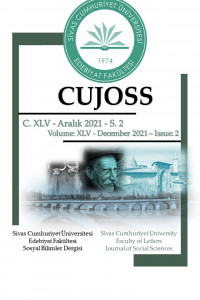HARUKI MURAKAMI’NİN KAFKA ON THE SHORE ROMANINDA GOTİK ÜZERİNDEN VAROLUŞSAL ABSÜRDİZMİN İNCELİKLERİNİ İRDELEME
Abstract
Felsefe ve edebiyat alanlarını bir araya getiren söz konusu çalışma, günlük hayatlarımız ve kurgusal eserlerin dünyaları arasında bir bağ kurmak niyetiyle ortaya çıkmıştır. Varoluşsal manada absürdizm, anlamdan yoksun olan evrende anlam bulma beklentimizin temelinde yatan çelişkiye atıfta bulunur. Sisifos miti üzerinden absürdizm felsefesini geliştiren Fransız filozof Albert Camus, absürdizm ve varoluşçuluk arasında bir ilişki olduğunu savunmuştur. Ancak bu çalışmanın ortaya çıkışının altında yatan esas amaç, edebiyattaki gotik türü ile varoluşsal absürdizmi harmanlayarak, gotik öğeler taşıyan bir romanda, varoluşsal absürdizmin izlerini keşfetmektir. Söz konusu amaç doğrultusunda, Haruki Murakami’nin Kafka on the Shore romanında, hem gotik hem de absürdizme örnek teşkil edebilecek kimi olaylar ve durumlar analiz edilecektir. Kişinin varoluşsal acıları gotiğe dair bir bakış açısıyla da irdelenebilir, zira mantık, amaç ve neşeden yoksun olan evren; mantıksızlık, kasvet, bilinmezlik ve garipliklerle tanımlanan gotik dünyası ile ilişkilendirilebilinir. Gotik romanın binbir türlü absürtlüğünde hapsolmuş karakterlermişizcesine, bizi gerçek dünyamızda çepeçevre saran absürdizmle mücadele etmek için ya umut ya da ölüme sıkı sıkıya sarılırız. Camus’nun belirttiği üzere, absürdizm ile tanışmamız neticesinde ortaya çıkan psikolojik buhran, ölüm arzularını beraberinde getirir. Ölüm, gotik roman için de, karakterlerinin kaçmaya çalıştığı ancak çoğunlukla bu konuda başarısız olduğu bir temadır; bu durum, varoluşçuların evren diye adlandırılan hiçlikte, intihar arzularından kaçamamalarıyla özdeşleştirilebilinir.
Keywords
References
- Botting, F. (1996). Gothic. New York: Routledge, Taylor & Francis Group.
- Camus, A. (1955). The Myth of Sisyphus and Other Essays ( J. O’Brien, Trans.). New York: Vintage Books Publishing Company.
- Freud, S. (1953). The ‘Uncanny’. In J. Strachey (Ed.), The Standard Edition of the Complete Psychological Works of Sigmund Freud, XVII, (219-252). London: Hogarth Press and the Institute of Psycho-Analysis.
- Hattenhauer, D. (2003). Shirley Jackson's American Gothic. Albany: State University of New York Press.
- Levine, G. & Knoepflmacher, U.C. (1979). The Endurance of Frankenstein: Essays on Mary Shelley’s Novel. Berkeley, Los Angeles, London: University of California Press.
- Murakami, H. (2006). Kafka On The Shore. New York: Vintage Books Publishing Company.
- Shelley, M. (1994). Frankenstein or The Modern Prometheus. New York: Dover Publications.
DIGGING INTO THE DEPTHS OF EXISTENTIALIST ABSURDISM THROUGH GOTHIC IN HARUKI MURAKAMI’S KAFKA ON THE SHORE
Abstract
This study aims to bring the realms of philosophy and literature together to create a link between our quotidian lives and fictional worlds. Absurdity in an existential sense means there is an internal contradiction in one’s aspiration to seek meaning in the universe which is destitute of such meaning. The correlation between absurdity and existentialism was asserted by Albert Camus who gained insights into absurdity by contemplating Sisyphus. Nonetheless, the purpose of this study is to blend existential absurdism with gothic genre to explore elements of existential absurdity and gothic echoes in Haruki Murakami’s Kafka on the Shore. One’s existential angst can be evaluated from a perspective which is also related to gothic, since the universe devoid of rationality, purpose and joy can be likened to gothic fiction whose attributes are also irrationality, gloominess and uncanny. To cope with the absurdity that surrounds us, as though we were characters trapped in manifold absurdities of gothic fiction, we resolutely cling to hope or death. Death is also a theme of gothic fiction from which characters endeavour to escape but mostly fail, like existentialists cannot escape from suicidal desires in nihility called the universe.
Keywords
References
- Botting, F. (1996). Gothic. New York: Routledge, Taylor & Francis Group.
- Camus, A. (1955). The Myth of Sisyphus and Other Essays ( J. O’Brien, Trans.). New York: Vintage Books Publishing Company.
- Freud, S. (1953). The ‘Uncanny’. In J. Strachey (Ed.), The Standard Edition of the Complete Psychological Works of Sigmund Freud, XVII, (219-252). London: Hogarth Press and the Institute of Psycho-Analysis.
- Hattenhauer, D. (2003). Shirley Jackson's American Gothic. Albany: State University of New York Press.
- Levine, G. & Knoepflmacher, U.C. (1979). The Endurance of Frankenstein: Essays on Mary Shelley’s Novel. Berkeley, Los Angeles, London: University of California Press.
- Murakami, H. (2006). Kafka On The Shore. New York: Vintage Books Publishing Company.
- Shelley, M. (1994). Frankenstein or The Modern Prometheus. New York: Dover Publications.
Details
| Primary Language | English |
|---|---|
| Journal Section | Research Article |
| Authors | |
| Publication Date | December 22, 2021 |
| Published in Issue | Year 2021 Volume: 45 Issue: 2 |
.

